There’s a newcomer to the Mustang stable, and it’s coming to the UK in right-hand drive. The Dark Horse now represents the top spec for the model’s new, seventh generation. It’s also the first new name for a Mustang performance trim since the Bullitt in 2001. Of course, that nomenclature was a Steve McQueen nostalgia play tapping into prior glory – a strategy essential to the retro-fueled pony car since 2005, which both the fifth-gen Boss 302 and the recent sixth-gen Mach 1 employed to great effect. The Dark Horse, though similar in concept to these predecessors, is all about looking ahead.
Without explicit heritage to call upon, the Dark Horse will instead draw credibility from racing. Though Mustangs have long been a familiar sight at tracks in America and occasionally abroad, Ford is stepping up its presence with new GT3 and GT4 variants of the Mustang Dark Horse for international endurance racing. To further drive home the point – that the Mustang is much more than a pony car – a racing-only Dark Horse R will be the focus of a new IMSA-sanctioned Mustang Challenge spec series.

What does that mean for the road-going Dark Horse you can actually buy? As with the outgoing Mach 1, the Dark Horse is both an aspirational step beyond a fully kitted GT as well as an incrementally more performance-oriented, track-capable tool.
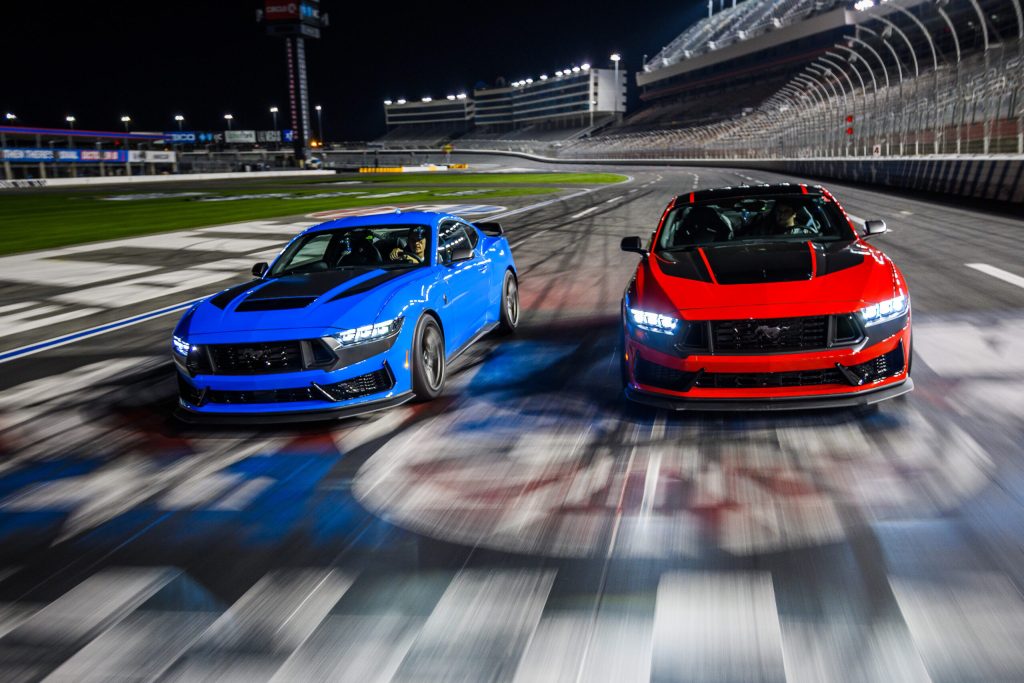
Incremental is the key word here – the Dark Horse is not a wholly different beast from the GT, but rather the result of many small tweaks that amplify the traits of an already excellent sports car. And, as with the Mach 1, the Dark Horse doesn’t sacrifice road manners for outright track prowess.
Ford provided a good setting for us to explore the Dark Horse’s personality, with ample laps on North Carolina’s Charlotte Motor Speedway roval (a blend of road course and oval) as well as time on public roads winding through the rural landscape. Luck of the draw gave us a base Dark Horse, with optional Recaro seats, for road duty.
Specs: 2024 Ford Mustang Dark Horse
Price: £60,000 (est.)
Powertrain: 5.0-litre V8; 6-speed manual or 10-speed automatic
Output: 500bhp
Torque: 418lb-ft
Layout: Rear-drive, two-door, four-passenger coupe
Fuel economy: 14–15mpg city / 23–24mpg highway
0–60mph: sub-4 sec (est.)
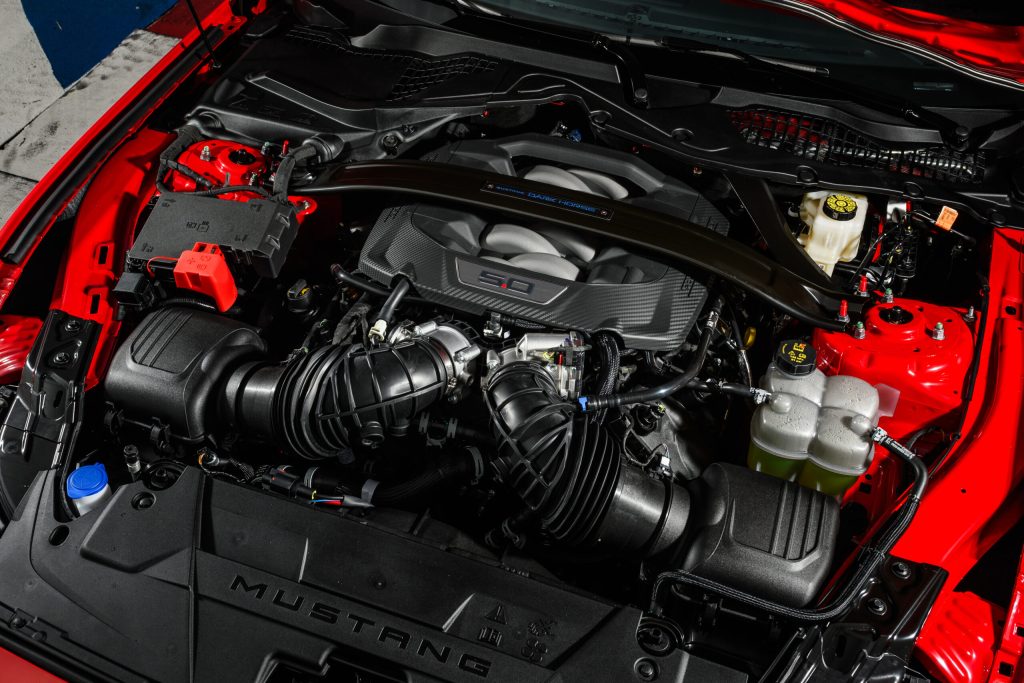
The performance-focused Dark Horse starts with tweaks to the 5.0-litre Coyote engine to reach an even 500 horsepower, from the Mustang GT’s max 486. Backing up the engine are two transmission choices: either the exceptional Tremec TR-3160 (an upgrade from the GT’s Getrag unit) or a version of the ten-speed automatic Ford initially developed with General Motors. Active exhaust valves come standard, as do MagneRide dampers. The larger brakes, wheels, and Pirelli P Zero tyres that come on the GT’s Performance Pack—along with some of that package’s suspension bits—are fitted as standard to the Dark Horse, but specific damper tuning, spring rates, and sway bars vary based on which Dark Horse trim you pick. In addition to other details we’ll highlight below, the Dark Horse’s Handling pack (sadly not available to UK buyers) yields a larger wheel and tyre combo, along with even stickier Pirelli Trofeo RS rubber.
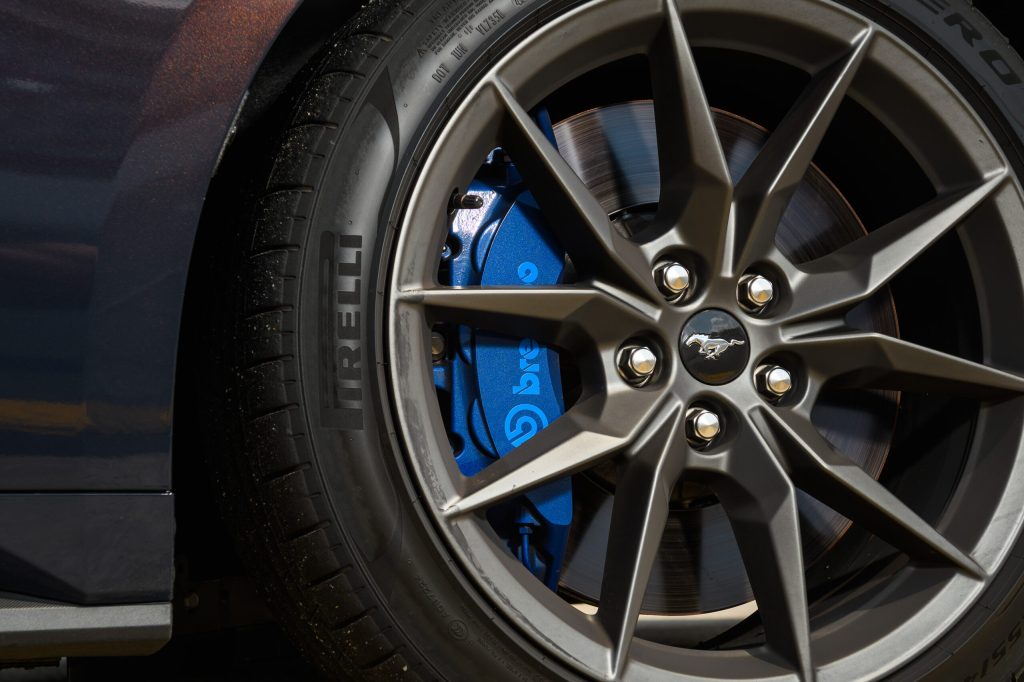
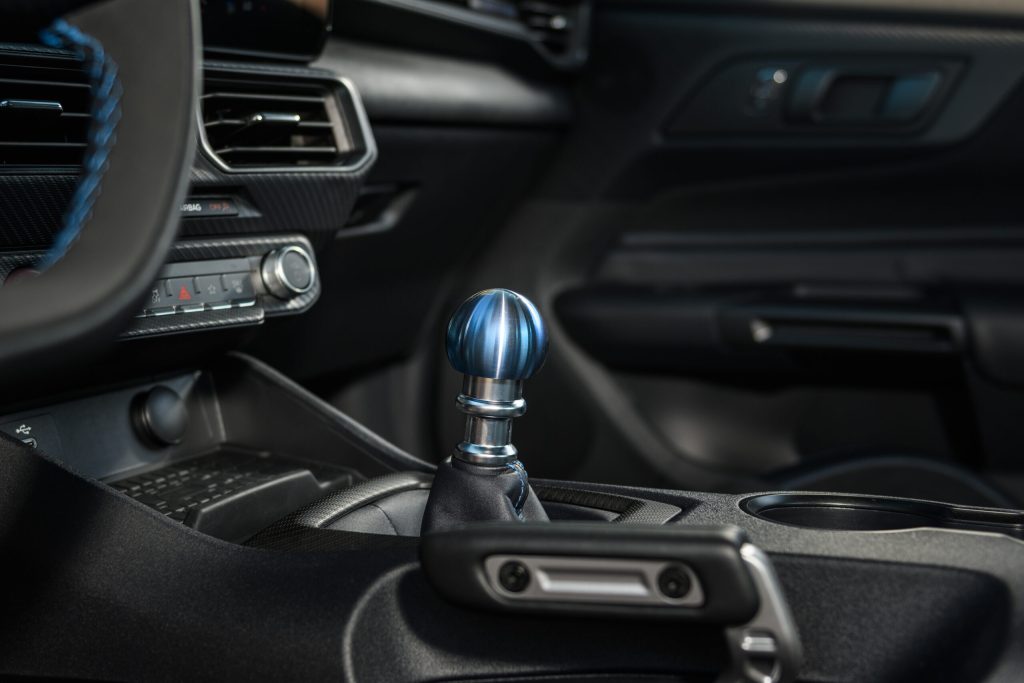
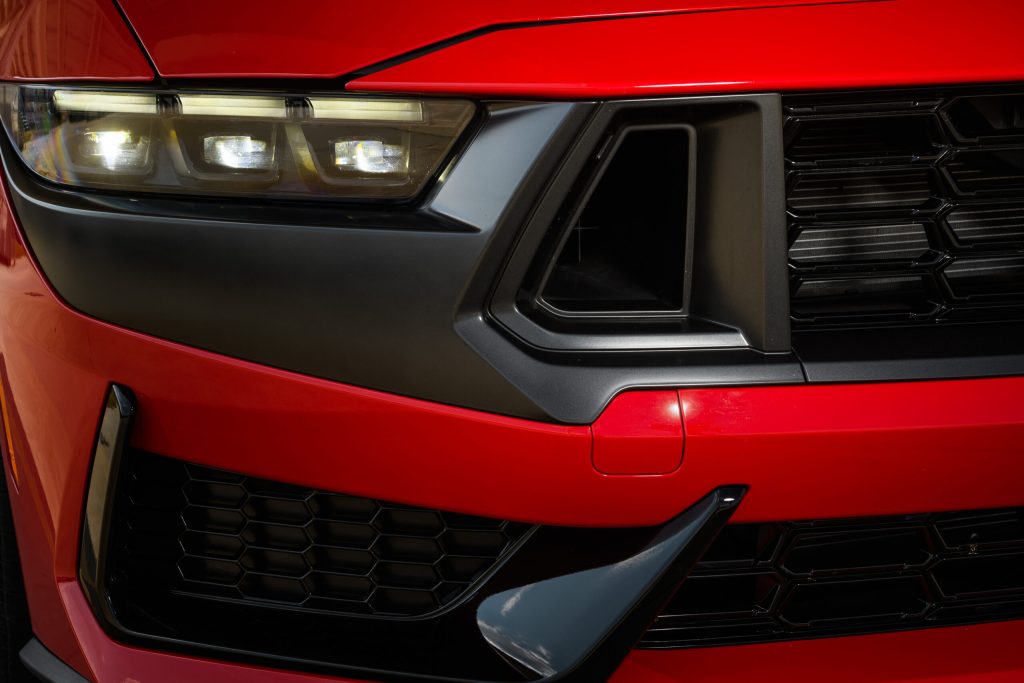
Hop inside a Dark Horse and the differences from the GT are subtle. There’s a numbered plaque ahead of the passenger, a unique screen start sequence, darker trim surfaces, and stitching differences. The Dark Horse Appearance Package adds attractive Deep Indigo blue leather. Your choice of seats boils down to relaxed or aggressive: The base models are more adjustable and have welcomed lumbar support and optional ventilation. They don’t hold you laterally, though, which is where the Recaros come in. They’re great for track work and were comfortable over a couple-hour journey but could use more adjustment and lumbar support.
The most noticeable change to the Mustang’s interior is the screen-dominated dashboard. The giant flat surface will remain jarring for many, but its configurability provides excellent vehicle information at a glance. In Track mode, the digital tach’s redline is centered for easy visibility, and the second screen can meanwhile display a whole suite of gauges – it’s clear the performance team got to crash the tech party, and we consider that a win, of sorts.
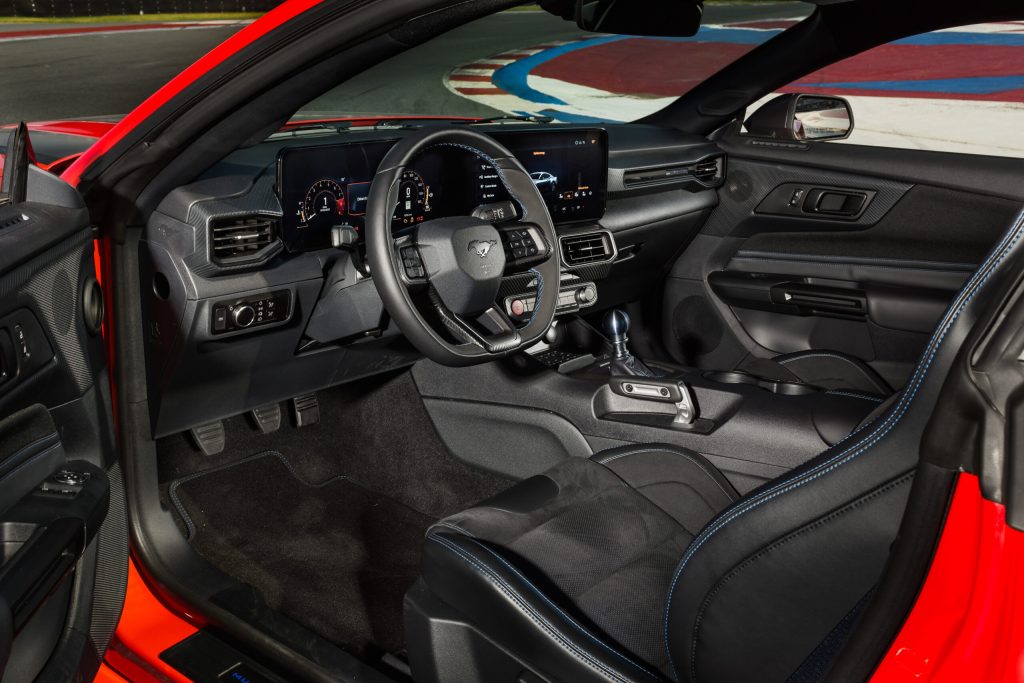
Ford’s decision to put technology at the forefront of this interior highlights a pivotal design decision – to move away from explicit call-outs to the 1960s Mustang. No chrome surrounds, no retro surfaces or shapes. Arguably, the last Mustang interior that didn’t reach back to the first-gen cars was the Fox-body Mustang, which ended production in 1993. The only vintage references in the latest-generation Mustang are the selectable Fox-body gauges, complete with illuminated green instruments like Gen X experienced all through the 1980s and ’90s. Time marches on, and once again, so does the Mustang.
Some things have not changed. Pulling out from the pits onto the banked oval immediately revealed the star of this package: the 500-horsepower Coyote V8/Tremec TR-3160 combination, which deserves a spot in the Sensory Joy Hall of Fame. All snarl and bass, the Coyote rips to its 7500rpm redline, rolling into its refrain again and again with each subsequent shift. Each short throw of the blue titanium shift ball requires considerable effort, rewarding you when the lever snaps into position with satisfying authority. Movement between the gates is precise and mechanical-feeling. Like any quality tool, good feedback makes the job easier, but also more enjoyable. The same can’t be said of the GT’s Getrag MT-82, whose linkage is comparatively imprecise.
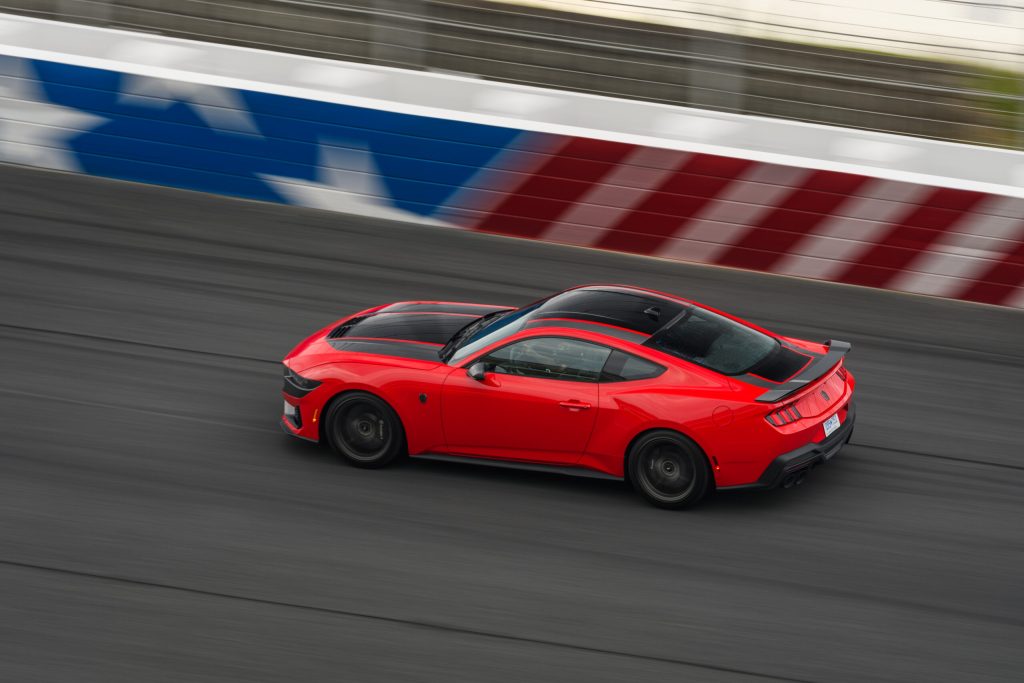
Those 500 horses are courtesy of some classic hot-rodding. The Dark Horse gets a balanced crankshaft, hardened camshafts, forged connecting rods, and a revised tune, all of which should aid in durability through extended periods of high-rpm tomfoolery. To further help keep the Dark Horse composed, Ford added coolers for the engine, transmission, and differential. They came in handy – temperatures on track at Charlotte cracked 38 degrees by midday, and none of the Dark Horses broke a sweat.
Opting for the ten-speed automatic provides slightly shorter gear ratios than in the automatic-equipped GT (the Tremec’s are shorter than the Getrag’s as well). The automatic gets a 3.55:1 Torsen limited-slip differential, while the manual gets a 3.73:1 Torsen. Ford didn’t issue hard numbers on acceleration, but expect a zero-to-60 sprint in under four seconds.
Heel-toe is easy with the well-spaced pedals (or you can let the Dark Horse rev match for you), and we couldn’t help but grin at the Coyote’s sharp barks on downshifts. The same six-piston Brembos up front and four-piston calipers in the rear from the GT’s Performance Package are standard here, and with the help of electronic boost they have no problem peeling nearly 100mph off the 3949-pound Dark Horse’s speed into a tight hairpin at the end of Charlotte’s back straight. Initial brake bite is not excessively grabby, and the pedal feels consistently firm.
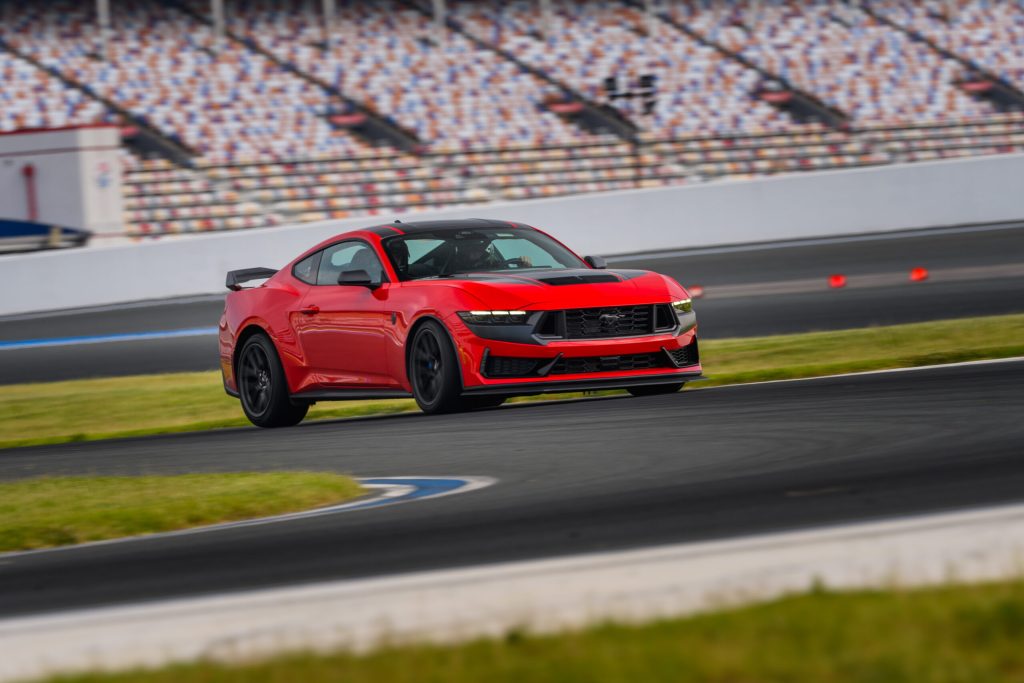
Turn-in isn’t over-eager. The Dark Horse instead hews old-school, encouraging trail braking on corner entry to help position the nose, while adjusting throttle facilitates line corrections throughout the corner. This is a willing, communicative chassis that most drivers will not find hairy or intimidating. Steering weight is a bit firmer than in the GT yet overall still lighter than in BMW M or GM performance cars. That’s a stylistic difference rather than a shortcoming, but we nonetheless wish for a bit more directness and response; changes in front end grip whether on track or street can be a bit muted through the steering wheel. That’s really our only quibble.
Plenty of Dark Horse owners will never see time on a road course, and these customers should not overlook the base car. It delivers during assertive street driving and enjoyable cruising, wearing the same Pirelli P Zeros that come on Performance Pack GTs, plus Ford’s supple yet superbly controlled MagneRide dampers with a unique tune. Like any Mustang these days, the Dark Horse can be as docile or devilish as your right foot demands. The car’s consistent balance across this wide performance threshold is what impresses us most.
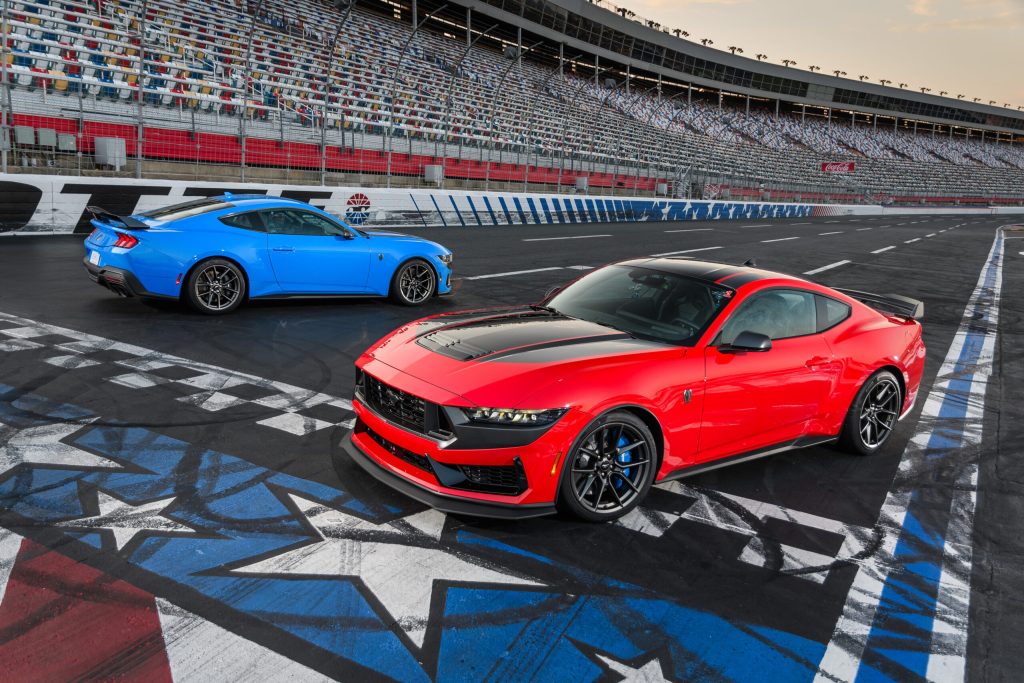
Ford’s pony car may have prioritized heritage for the last couple of decades, but it’s always been an aspirational choice. In that respect, the Dark Horse is not as much of a pivot as it may appear. Like the Mach 1 before it, this car is hard-wired for the heart more than the head. Big performance, big street presence, and big, impressive name. That those same ingredients have been spun into a fresh recipe should please Mustang fans old and new. And for the most dedicated traditionalists, we have to believe a Shelby version will be added to the menu soon.
2024 Ford Mustang Dark Horse
Highs: Rewarding to drive in any context – winding road, open boulevard, or closed circuit. Thunderous sound and tactile feedback that is becoming increasingly rare.
Lows: Could use a touch more front-end grip. Base seats would be perfect with more lateral support.
Takeaway: A high-performance, high-emotion Mustang for generations both present and future.



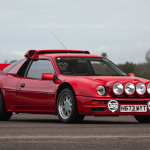













About time too, a real 1970 Boss 302 copy plus. Might now think of buying one, instead of the weak imitators over the last few years. Pension savings goodbye ? .